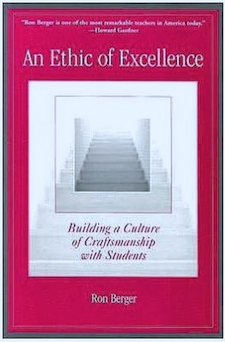Building a Culture of Excellence
An Ethic of Excellence: Building a Culture of Craftsmanship with Students
By Ron Berger
(Heinemann, 2003 – Learn more)
I first heard about An Ethic of Excellence on the Cooperative Catalyst. Since it received high accolades from a reliable source, I immediately purchased my own copy. I thought it was a brand new book and was surprised to discover that it had been published in 2003 at the beginning of the NCLB era but before the current and evermore popular denigration of public education and public school teachers.
Yet, as all good books are wont to do, the ideas Ron Berger puts forth are timeless and timely, which leads me to muse that perhaps this book should be shelved under classics? Or, maybe even in a genre I’ve named, iconoclastic professional literature? In any case, An Ethic of Excellence: Building a Culture of Craftsmanship with Students did not disappoint. This book not only helps teachers focus or refocus, as the case may be, on the importance of school and classroom culture as an essential component for developing an ethic of excellence in and for students and teachers, but it also offers concrete suggestions for doing so.

Designers and builders must communicate
On page 7, Berger makes the following assertion: “If we want citizens who value integrity, respect, responsibility, compassion and hard work, we need to build school cultures that model those attributes.” Teachers working in any setting – public, private, charter, international, parochial – know this to be true in their heart of hearts. Schools whose leaders say the right words but don’t practice the critical attitudes Berger highlights above, cannot model what this looks like to the teachers and students under their care. It is a truism that leadership determines the culture – the values and practices – of schools.
Throughout his book, Berger uses the metaphor of “the building site vs. the architecture firm” (p. 10), and recognizes the importance of both the builders and the architects in the creation of a building. On the construction site or in the design room, one cannot exist without the other. Even though each side may engage in bashing the other as not having the right lenses when it comes to practical and design issues, respectively, they must talk to each other if an architectural project is to be successful, aesthetically and practically speaking.
However, this is not the case with the current education debate. The architects (the so-called reformers) are not including the builders (the teachers) in the public conversation about education. In fact, the architects denigrate the builders, creating a no-win situation for children and teachers. This must change in order for the focus to shift from a culture of high stakes testing to “an ethic of excellence” in classrooms.
What it means to do excellent work
Berger lays out important ideas for teachers to keep in mind if they want to create and cultivate a school culture that respects and models excellence for students so they can imitate (p. 85) and maintain it for themselves, long after they’ve left the schoolhouse.
He recommends that teachers collect models of strong, beautiful work that help children visualize images of quality in their heads. Children must understand, however, that these samples often require multiple drafts before the work reaches a level of excellence that we can be proud of and that others recognize as such. Berger says, “It means final drafts may take days or weeks to complete. It means a different type of pressure: not just pressure to turn in enough work but pressure to produce something of real value,” (p. 87). And later, “Students need to know from the outset that quality means rethinking, reworking, and polishing,” (p. 90).
For teachers laboring under the current testing regimes, this seems undoable. Nevertheless, if we are truly committed to redesigning school cultures so that what we count is what matters and what matters is what we count, then we would do well to heed Berger’s words about expectations of excellence. This would make schools and classrooms real laboratories for thinking, innovation, and intellectual work that also consider the emotional investment of a culture of excellence.
Three toolboxes for our teaching
True to his metaphor of construction and architecture (and his own background as a carpenter), Berger divides the bulk of his book into three sections: The First Toolbox: A School Culture of Excellence, The Second Toolbox: Work of Excellence, and The Third Toolbox: Teaching of Excellence. Each section provides examples from the classroom and tips to help teachers move along the continuum of an ethic of excellence, guiding themselves and their students to appreciate and promote this culture in everything they do. It was heart-warming to read accounts of former students who still carry with them these experiences from when they were in Berger’s class.
Berger uses the critique of student work as a cornerstone for moving towards a classroom culture of excellence. This critique is done by the students as well as the teacher and outside experts. All work has the potential of becoming public (and often does) so students are doubly aware of the need for excellent work that produces important knowledge others can use and build upon. This is similar to what the researcher must keep in mind when approaching a research project. The fact that this ethic is being promoted by Berger’s adherents among children of all ages is worthy of study.
Berger, who today leads the Expeditionary Learning school network, concludes his book with a teacher’s archetypical question, which he refers to as “a deeper question, something beyond the data. How do I really know what I have done for students? How do I know what my school has done for students in the long run? How does one measure something like this?” (p. 154). Not surprisingly, he finds his answers in the students themselves, some of whom are now adults carrying out social and civic roles in his town: “They take pride in doing their best. They have an ethic of excellence,” (p. 154).
Elisa Waingort has been teaching in bilingual settings for more than 25 years in public and international schools in North and South America. She is currently teaching ESL to fourth through eighth grade students at Academia Cotopaxi, an American International School in Quito, Ecuador. Elisa blogs at ateachersruminations.blogspot.com and at the Cooperative Catalyst. She is also a member of the Elementary Section Steering Committee of the National Council of Teachers of English and serves on NCTE’s Executive Committee.
































